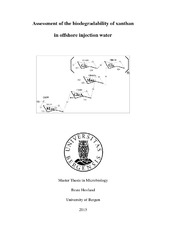| dc.description.abstract | The application of biopolymers in EOR operations is considered environmental friendly compared to synthetic polymers. However, microbial degradation of the biopolymers may lead to a deterioration of effect in EOR applications. This thesis is part of an industrial project conducted by UNI Research CIPR for Statoil ASA, were the aim is to assess biodegradation of xanthan at specific oil field conditions. Investigation of the biodegradation of xanthan was performed in two anoxic brines from a North Sea oil field, sulfate reduced sea water (SRP) and produced water for reinjection (PWRI). The biodegradation was assessed in a bioassay with xanthan as the sole added carbon source, at temperatures reflecting various locations in the oil reservoir. Reduction in viscosity, bacterial growth and shift in the bacterial community composition was used to verify xanthan degradation. Biodegradation was not demonstrated in the bioassays. The SRP brine showed enrichment of bacteria affiliated to Methylophaga sp. and Microbacterium sp. after incubation at mesophilic conditions. Phylotypes affiliated to Petrotoga halophila, Petrotoga mobilis, Thermosipho geolei and Kosmotoga olearia were enriched in the PWRI brine at thermophilic conditions. A facultative anaerobic sugar degrading bacterium, with 100% sequence similarity to Aeribacullus pallidus was isolated from the PWRI brine at 60°C by plating on LBA. The strain preferred growing on solid medium. The strain was able to grow anaerobically on glucose (by fermentation), thereby differing from the type species classified as strict aerobic. Xanthan supported growth at aerobic conditions. Biodegradation of xanthan was observed in a later experiment when the incubation time at mesophilic conditions was extended. A control experiment verified biodegradation, and a bacterium affiliated to Prolixibacter bellariivorans (98%sequence similarity) was identified as the putative xanthan degrader. | en_US |
